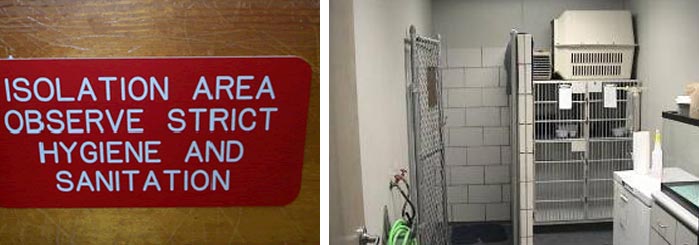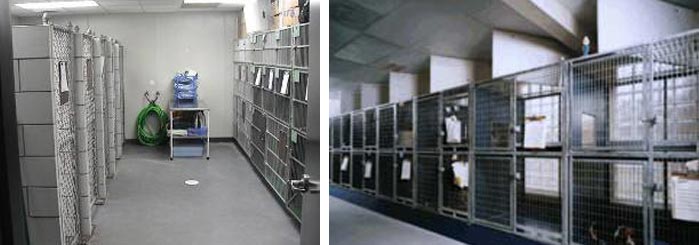First Impressions are Lasting Impressions
Keeping the clinic clean and neat in appearance is a big responsibility and a critical part of working and operating a dog kennel, or veterinary clinic. One of the first impressions a customer has of your workplace is cleanliness and the odor. If the clinic has an unsightly scent or odor, the client is going to have the impression that you do not clean on a daily basis. They are not going to understand that an animal that just left expressed its anal sacs all over the room, they just know that they do not want their treasured animal in an environment that is unclean.
- Keep your clinic clean and neat and tidy
- Make a good overall first impression
- Avoid unpleasant odors (this is one of the things that people notice first)

Clients Observe and Smell
The clinic needs to have good enough ventilation to help with any odor problem. Even if there is no unpleasant scent, clients notice the hair that seems to be attracted to every area of the clinic. Air conditioning ducts and ceiling fans are areas that are usually forgotten. It is useful to have every day and weekly checklists of cleaning obligations. As a task is completed, the employee initials it. This aids in the entire job being finished in a timely matter.
- Adequate ventilation and airflow facilitates the removal of odors
- Air conditioning ducts and ceiling fans are frequently forgotten areas
- Have daily and weekly cleaning tasks

Front Desk and Waiting Area
This is the area that most clients will notice first. Ensure that paperwork, files, and so on, are stacked neatly well that it doesn’t appear that you won’t be able to find anything. This is for appearance and function. Clients will not be impressed if you can’t find their file. Make certain that documents are alphabetized efficiently and filed away in a timely manner. The floor must be swept regularly and if anything is left behind by the previous patient, such as urine or feces, that ought to be cleaned immediately.
- Keep front desk free from clutter
- Keep files alphabetized so they can easily be called upon
- Keep the floor clean and swept on a regular basis

Exam Rooms
Every exam room including the table, counter top, floor, etc. needs to be cleaned and sterilized after each client. If there is urine, toenails, hair or any other waste anywhere in the room, the client is going to notice. The examination table should be cleaned with a chemical that is effective against viruses and bacteria. Due to continuously mutating microorganisms, the best protection is to wipe the table with a mixture of bleach water and then a gluteraldehyde chemical or something that is comparable. Make certain that you wipe down table so that there is no remaining chemical. Some of the chemical compounds you will use for cleansing could burn the paws and pads of the next patient. Make sure the table is completely dry. Always use gloves when you are cleaning with cleansers and disinfectants. Always use the recommended dilution for chemicals and also remember to never mix disinfectants.
Always empty the garbage in a timely manner, especially if the paper towels used for anal sac expression are in the garbage can. This pungent odor permeates everything. The weighing of patients on scales should also be cleaned after each and every patient. You may never know the previous procedure that took place. It may have carried a viral infection, bacteria or parasites or a viral infection that might get transmitted by indirect contact. You certainly would not want a patient to get sick because of something it was exposed to while in your clinic. If this does happen, it is called a “nosocomial infection.” Make double sure that you wash your hands with an antiseptic soap after restraining patients for the same reason.
- After every client exam rooms should be cleaned
- Clean with chemicals that kill viruses and bacteria
- Wipe away any chemical residues that may still be present
- Regularly empty the garbage cans
- Clean scales after each patient
- Always remember to wash your hands after each and every patient

Treatment Area
- Clean the treatment area frequently
- This is the area where most hospitalized patients are kept
- Follow all directions on the product label and always use the proper dilution ratio

Parking Lot & Backyard Area
The parking lot is an area that is commonly forgotten. Be sure to pick up all trash and any feces left by any previous patients on a daily basis. Wherever the dogs are walked, the feces should be picked up every single day, if not more often. This will help cut down the risks of a harmful disease spreading and also keeps the dogs cleaner.
- Debris and feces from the dog walking area must be cleaned daily
- Remember that clients notice these kinds of things, first impressions count!

Isolation Area
The isolation ward must be cleaned daily. It is commonly the area where animals are diagnosed or suspected of having a disease that might be highly contagious such as feline leukemia or parvo. If an animal that is hospitalized is shedding a virus, such as parvo, you must clean often. When the animal is recovering, it doesn’t need to ingest the virus all over again. It’s always a good idea to have a shallow tub of bleach water near the exit door so that you can step into it to effectively kill any body waste on the bottom of your shoes. Always take care not to track a virus across the floor of the clinic. Feeding bowls, trash cans, cleaning tools, etc. should stay in isolation.
Try not to mix these items with the items that are used daily for boarders. Make sure this room is thoroughly cleaned on a weekly basis if there has not been any patient being kept in there. Wash the cages, walls, under and behind cages, trash cans, cabinet doors and entrance/exit doors with bleach water and then finish off with a glutaraldehyde chemical. Bleach water can be highly effective against some microorganisms, but not all of them. The same is true for glutaraldehyde; thus, it is smart to use a combination of the two. Always remember to wipe dry between the use of different chemicals. Some combinations of these chemicals could potentially produce a toxic inhalant.
When emptying the trash from and isolation area, be sure to double bag it. Once you finished cleaning the isolation area, whether a clients patient is currently being hospitalized in there or not, thoroughly wash your hands before touching or handling anything in the clinic, especially the other patients.
- This is where animals with highly contagious diseases are held
- Keep a tub of bleach water at the isolation door to clean off the bottoms of your dirty shoes
- Always have a separate set of bowls for feeding, trash cans, cleaning tools, etc. for this area
- Thoroughly clean and disinfect the isolation area once a week if no patient is being kept here
- Double bag all of the trash that is taken away from this area

Kennel
It’s always a constant battle cleaning the kennel; unless you don’t not have animals staying in the kennel area, it will probably never be completely clean. Your boarders are going to consistently need their cages and runs cleaned. Use a bleach water solution or a glutaraldehyde. When cleaning a cage, it is not sufficient enough to just wipe down the floor of the cage. Clean the walls, floor door, ceiling etc. When using bleach water to clean the cage, make sure the cage is completely dry before putting an animal into it.
If you are using it in a run that has a drain, make sure to rinse it several times over. Bleach can burn through the dogs paw pads and you don’t want to explain to the owner why their pet needs ointment put on its feet. Line cages with newspaper, its the best at absorbing water or urine. Be careful if putting a white animal on newspaper. If the newspaper happens to get wet, the ink can soak off and you do not want the owners dog with newspaper ink all over it. Use a blanket that is clean or a towel with very light colored animals. If your clinic uses cards, make sure that the card gets transferred with the animal if you move it to a another cage. An very unhappy client is one that comes to pick up their animal and the wrong pet gets brought to them.
Its always a good idea to use a combination of cage cards with a name tag that goes around the the patients neck. When moving animals to another cage, make sure the new cage is completely cleaned first. It doesn’t make a good impression if a pet becomes ill while boarding at your facility.
- Keeping the kennel clean will always be a constant battle
- Clean the walls, floor, door on a cage and ceiling
- Don’t put an animal in a cage unless it is completely dry
- Newspaper soaks up water and urine and is a good liner
- Try to use cage cards and name tags if possible

Visit our showroom in Toronto for a Rotowash demonstration!
Our Address:
Kleen Kuip Supply Mart Inc.
11 Banigan Drive
Toronto, ON Canada
M4H1G3
Phone: 416-429-0401 (Local Toronto)
Toll Free: 1-800-565-2574 (Out of Town)
Hours of operation:
8:30am to 4:30pm Monday to Friday
We have a full Service, Parts and Repair Shop





